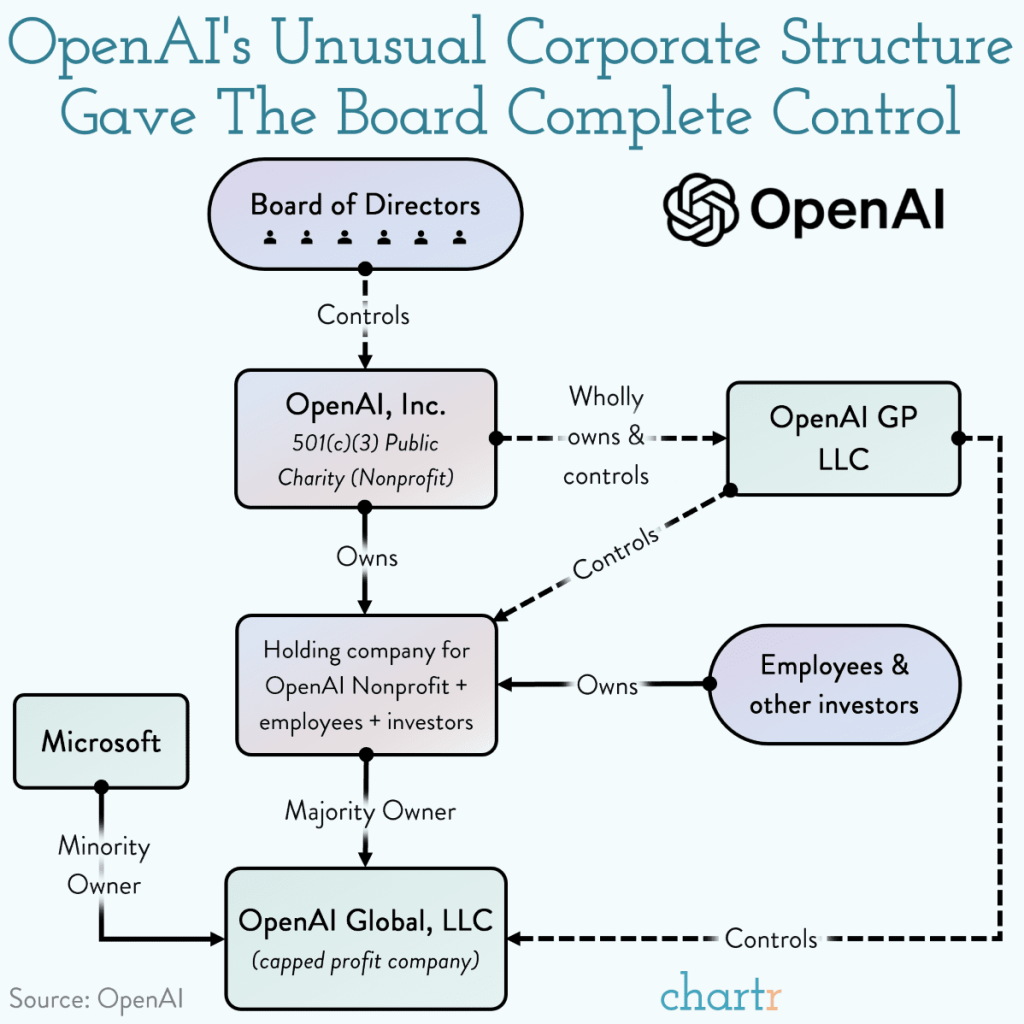
One Year of ChatGPT: Board-CEO Tension vs. Employee Loyalty
The release of ChatGPT just one year ago was without question a technological and cultural watershed moment. It firmly established generative AI within the public consciousness and catapulted its developer OpenAI into the spotlight of AI development. But instead of celebrating the anniversary, OpenAI made headlines through the rapid firing and re-hiring of star CEO Sam Altman.
What does that whirlwind weekend tell us about OpenAI, its mission and its people? And perhaps more intriguingly, how come Altman managed to return so rapidly, after his unceremonious dismissal?
Tension between Principle and Profit
One recurring thread in much of the reporting about the Altman saga, is that OpenAI’s unique structure allowed a very small group of people to fire Altman without consulting any of the investors or leadership.
The company was initially established as a non-profit, with the later addition of a for-profit arm. It is worth noting here that Microsoft invested significant amounts of money in the company and is a minority owner of the for-profit entity, which is still under the ultimate control of the non-profit board.

Any observer of the AI industry will be aware of the tension between commercialism and the push for caution and legislation. The corporate structure of OpenAI really reflects this tension: a non-profit, established with the goal to “build safe and beneficial artificial general intelligence (AGI)”, increasingly under pressure to generate profit, in part driven by investors. The official explanation for Altman’s dismissal is opaque, but one of the board members involved in his firing was Ilya Sutskever, who is notoriously committed to AI safety.
In fact, quite a few commentators have speculated that Altman and the board were not aligned on matters of ethics and research safety. Altman had previously clashed with another board member over a research paper she had written, criticising OpenAI over lacking safekeeping their technology. Did the board feel that Altman was veering too far into commercialism and by doing so, compromising the founding principles of the company? What role did Microsoft play in all this, considering they lost no time securing Altman as a potential employee and publicly supported him, even if he should choose to return to OpenAI?
A Culture of Loyalty
“We are unable to work for or with people that lack competence, judgement and care for our mission and employees.” OpenAI employees’ letter to the board
The other recurring element in the Altman saga, is the open letter to the board. Eventually having been signed by almost 95% of the company’s employees the letter unambiguously declares the board incompetent and calls for the board members resignation, as well as Altman’s return. The signees of the letter also threatened that, should their demands not be met, they would resign and move to an Altman-led Microsoft subsidiary. The letter also accuses the board of not acting in the best interest of the company and its mission – an intriguing claim given that one of the many signees of the letter was Ilya Sutskever, one of the likely instigators of Altman’s firing.
How can it be that both the employees and the board of the company claim to be protecting the principles and interest of OpenAI, and yet are clearly at odds? Additionally, with only about 770 employees, OpenAI is relatively small in the world of tech giants – yet almost all these people signed a letter in support of Altman. In some cases, resigning from OpenAI would have come at significant personal cost, like the loss of a work visa. What did Sam Altman do to inspire such loyalty and dedication among his employees?
Not all those signatures will have come from a place of personal loyalty, though Altman is often described as a charismatic leader and communicator. But it seems like Altman is perceived as a crucial element of the company’s success and cohesion, making his removal an attack on the integrity of OpenAI.
The Aftermath
As the Altman saga was very publicly playing out, Elon Musk – who has a complicated relationship with OpenAI himself – published a link to another open letter. The authors of this letters remained anonymous but claimed to be former OpenAI employees.
In their letter to the board, they make various claims of misconduct towards Altman and former chairman of the board, Greg Brockman. This letter accuses them of creating “an environment of fear and intimidation”, and deliberately silencing or pushing out anyone who had dared to voice their concerns.
While none of these accusations have been verified so far, the mere existence of the letter suggests a slightly more sinister bent to the sweeping loyalty Altman seems to enjoy at OpenAI. Given that Altman has triumphantly returned, and the board will be undergoing a reshuffle, it seems likely that this second letter will fall on deaf ears.
What is clear, is that Altman emerges from the chaos as a winner, and that OpenAI’s employees remain clearly united in their purpose.
Sources
95 Percent of OpenAI Employees Threaten to Follow Sam Altman Out the Door | WIRED
Archived Copy of OpenAI Message to the Board · GitHub
Before Altman’s Ouster, OpenAI’s Board Was Divided and Feuding – The New York Times
Big Questions We Still Have About What Went Down at OpenAI
Control Alt delete: Exploring OpenAI’s corporate structure, after Sam Altman’s shock dismissal
Elon Musk Trolls His Way Into the OpenAI Drama | WIRED
How OpenAI’s Bizarre Structure Gave 4 People the Power to Fire Sam Altman | WIRED
Most of OpenAI’s employees threaten to quit if Sam Altman isn’t reappointed CEO | TechCrunch
OpenAI will benefit from unity of purpose with Sam Altman’s return | TechCrunch
OpenAI’s initial new board counts Larry Summers among its ranks | TechCrunch
Sam Altman’s firing at OpenAI reflects schism over future of AI development | Reuters
The Employee Letter to OpenAI’s Board – The New York Times
Why CEO Sam Altman’s firing at ChatGPT maker Open AI was bound to happen : NPR

